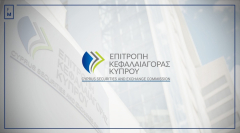Wednesday, 26/06/2024 | 13: 12 GMT by
Jared Kirui
- MiCA has introduced new categories of entities under CySEC’s supervision, including offerors of crypto-assets.
- CySEC has invited stakeholders to give their views by July 17, 2024.
Cyprus Securities and Exchange Commission (CySEC) has
launched a consultation to gather market views on the proposed fees and
reporting requirements under the Markets in Crypto-Assets Regulation (MiCA).
This initiative invites stakeholders to give their opinions and influence the
future framework, with responses due by July 17, 2024.
MiCA aims to establish a unified regulatory framework
for crypto-assets across Europe. It targets crypto-assets that are fungible but
not classified as financial instruments. The regulation, effective from May 31,
2023, seeks to create clarity and consistency within the crypto market.
The regulation categorizes crypto-assets into three
main types: asset-referenced tokens (ARTs), electronic money tokens, and other crypto-assets.
Besides that, the MiCA has introduced new categories of entities that will be under
the supervision of CySEC.
These include the offerors of crypto-assets, issuers
of ARTs, excluding credit institutions, entities issuing
asset-referenced tokens, and crypto-asset service providers.
Already, the MiCA regulations have led to notable changes in the industry. This month, Binance announced plans to make changes to ensure compliance in its trading on rewards platforms. Under the MiCA framework, only regulated firms can
issue and offer stablecoins. Currently, many existing stablecoins on Binance do
not meet these criteria and will be designated as unauthorized stablecoins, the
cryptocurrency exchange said.
MiCA Takes Effect
Meanwhile, the ESMA has laid out a comprehensive plan
to address crypto-related risks and establish a regulatory framework for the
digital asset space under MiCA. These measures, encompassing authorization,
governance, conflict resolution, and complaint handling procedures, seek to strengthen
the crypto ecosystem.
The first package, set to launch in July 2023, regards
mandates, such as notification content, application for authorization, and complaint handling procedures.
Already, MiCA is bearing positive results in the
digital asset space. According to a report by global identity intelligence
company AU10TIX, fraudulent activities have moved away from the cryptocurrency
space, marking a significant decline of 51% in attacks attributed to the
implementation of the Market in Crypto Asset (MiCA) regulation .
Additionally, the report disclosed how regulatory crackdowns in the digital asset space are redirecting fraudsters toward the payments sector. The report highlighted a 56% growth in fraud in the payments sector, boosted by factors like increased digital transaction volumes in the Asia Pacific region and the economic recovery in North America.
Cyprus Securities and Exchange Commission (CySEC) has
launched a consultation to gather market views on the proposed fees and
reporting requirements under the Markets in Crypto-Assets Regulation (MiCA).
This initiative invites stakeholders to give their opinions and influence the
future framework, with responses due by July 17, 2024.
MiCA aims to establish a unified regulatory framework
for crypto-assets across Europe. It targets crypto-assets that are fungible but
not classified as financial instruments. The regulation, effective from May 31,
2023, seeks to create clarity and consistency within the crypto market.
The regulation categorizes crypto-assets into three
main types: asset-referenced tokens (ARTs), electronic money tokens, and other crypto-assets.
Besides that, the MiCA has introduced new categories of entities that will be under
the supervision of CySEC.
These include the offerors of crypto-assets, issuers
of ARTs, excluding credit institutions, entities issuing
asset-referenced tokens, and crypto-asset service providers.
Already, the MiCA regulations have led to notable changes in the industry. This month, Binance announced plans to make changes to ensure compliance in its trading on rewards platforms. Under the MiCA framework, only regulated firms can
issue and offer stablecoins. Currently, many existing stablecoins on Binance do
not meet these criteria and will be designated as unauthorized stablecoins, the
cryptocurrency exchange said.
MiCA Takes Effect
Meanwhile, the ESMA has laid out a comprehensive plan
to address crypto-related risks and establish a regulatory framework for the
digital asset space under MiCA. These measures, encompassing authorization,
governance, conflict resolution, and complaint handling procedures, seek to strengthen
the crypto ecosystem.
The first package, set to launch in July 2023, regards
mandates, such as notification content, application for authorization, and complaint handling procedures.
Already, MiCA is bearing positive results in the
digital asset space. According to a report by global identity intelligence
company AU10TIX, fraudulent activities have moved away from the cryptocurrency
space, marking a significant decline of 51% in attacks attributed to the
implementation of the Market in Crypto Asset (MiCA) regulation .
Additionally, the report disclosed how regulatory crackdowns in the digital asset space are redirecting fraudsters toward the payments sector. The report highlighted a 56% growth in fraud in the payments sector, boosted by factors like increased digital transaction volumes in the Asia Pacific region and the economic recovery in North America.
![]()
- 991 Articles
- 11 Followers
Jared is an experienced financial journalist passionate about all things forex and CFDs.
- 991 Articles
- 11 Followers
More from the Author
-

Trading Technologies Teams Up with Hidden Road to Expand Services with Unified Platform
Trading Technologies Teams Up with Hidden Road to Expand Services with Unified Platform
Trading Technologies Teams Up with Hidden Road to Expand Services with Unified Platform
Trading Technologies Teams Up with Hidden Road to Expand Services with Unified Platform
Trading Technologies Teams Up with Hidden Road to Expand Services with Unified Platform
Trading Technologies Teams Up with Hidden Road to Expand Services with Unified Platform
Trading Technologies Teams Up with Hidden Road to Expand Services with Unified Platform
Trading Technologies Teams Up with Hidden Road to Expand Services with Unified Platform
Trading Technologies Teams Up with Hidden Road to Expand Services with Unified Platform
Trading Technologies Teams Up with Hidden Road to Expand Services with Unified Platform
-

amana Taps Jack Saidy as Director of Operations in Lebanon
amana Taps Jack Saidy as Director of Operations in Lebanon
amana Taps Jack Saidy as Director of Operations in Lebanon
amana Taps Jack Saidy as Director of Operations in Lebanon
amana Taps Jack Saidy as Director of Operations in Lebanon
amana Taps Jack Saidy as Director of Operations in Lebanon
amana Taps Jack Saidy as Director of Operations in Lebanon
amana Taps Jack Saidy as Director of Operations in Lebanon
amana Taps Jack Saidy as Director of Operations in Lebanon
amana Taps Jack Saidy as Director of Operations in Lebanon
-

Klarna Sells Checkout Unit for $520M, to Focus on Payment Service Provider Partnerships
Klarna Sells Checkout Unit for $520M, to Focus on Payment Service Provider Partnerships
Klarna Sells Checkout Unit for $520M, to Focus on Payment Service Provider Partnerships
Klarna Sells Checkout Unit for $520M, to Focus on Payment Service Provider Partnerships
Klarna Sells Checkout Unit for $520M, to Focus on Payment Service Provider Partnerships
Klarna Sells Checkout Unit for $520M, to Focus on Payment Service Provider Partnerships
Klarna Sells Checkout Unit for $520M, to Focus on Payment Service Provider Partnerships
Klarna Sells Checkout Unit for $520M, to Focus on Payment Service Provider Partnerships
Klarna Sells Checkout Unit for $520M, to Focus on Payment Service Provider Partnerships
Klarna Sells Checkout Unit for $520M, to Focus on Payment Service Provider Partnerships
-

Nvidia and Qatar’s Ooredoo Collaborate, Defying US AI Export Restrictions in Middle East
Nvidia and Qatar’s Ooredoo Collaborate, Defying US AI Export Restrictions in Middle East
Nvidia and Qatar’s Ooredoo Collaborate, Defying US AI Export Restrictions in Middle East
Nvidia and Qatar’s Ooredoo Collaborate, Defying US AI Export Restrictions in Middle East
Nvidia and Qatar’s Ooredoo Collaborate, Defying US AI Export Restrictions in Middle East
Nvidia and Qatar’s Ooredoo Collaborate, Defying US AI Export Restrictions in Middle East
Nvidia and Qatar’s Ooredoo Collaborate, Defying US AI Export Restrictions in Middle East
Nvidia and Qatar’s Ooredoo Collaborate, Defying US AI Export Restrictions in Middle East
Nvidia and Qatar’s Ooredoo Collaborate, Defying US AI Export Restrictions in Middle East
Nvidia and Qatar’s Ooredoo Collaborate, Defying US AI Export Restrictions in Middle East
-

VanEck Proposes 0.2% Fee for Ether ETF Following Partial Regulatory Win
VanEck Proposes 0.2% Fee for Ether ETF Following Partial Regulatory Win
VanEck Proposes 0.2% Fee for Ether ETF Following Partial Regulatory Win
VanEck Proposes 0.2% Fee for Ether ETF Following Partial Regulatory Win
VanEck Proposes 0.2% Fee for Ether ETF Following Partial Regulatory Win
VanEck Proposes 0.2% Fee for Ether ETF Following Partial Regulatory Win
VanEck Proposes 0.2% Fee for Ether ETF Following Partial Regulatory Win
VanEck Proposes 0.2% Fee for Ether ETF Following Partial Regulatory Win
VanEck Proposes 0.2% Fee for Ether ETF Following Partial Regulatory Win
VanEck Proposes 0.2% Fee for Ether ETF Following Partial Regulatory Win
-

Coinbase Tops Crypto Phishing Targets in Latest Survey
Coinbase Tops Crypto Phishing Targets in Latest Survey
Coinbase Tops Crypto Phishing Targets in Latest Survey
Coinbase Tops Crypto Phishing Targets in Latest Survey
Coinbase Tops Crypto Phishing Targets in Latest Survey
Coinbase Tops Crypto Phishing Targets in Latest Survey
Coinbase Tops Crypto Phishing Targets in Latest Survey
Coinbase Tops Crypto Phishing Targets in Latest Survey
Coinbase Tops Crypto Phishing Targets in Latest Survey
Coinbase Tops Crypto Phishing Targets in Latest Survey
Institutional FX
-

Digital Vega Links Up with FactSet to Broaden FX Options Reach
Digital Vega Links Up with FactSet to Broaden FX Options Reach
Digital Vega Links Up with FactSet to Broaden FX Options Reach
Digital Vega Links Up with FactSet to Broaden FX Options Reach
Digital Vega Links Up with FactSet to Broaden FX Options Reach
Digital Vega Links Up with FactSet to Broaden FX Options Reach
Digital Vega Links Up with FactSet to Broaden FX Options Reach
Digital Vega Links Up with FactSet to Broaden FX Options Reach
Digital Vega Links Up with FactSet to Broaden FX Options Reach
Digital Vega Links Up with FactSet to Broaden FX Options Reach
-

Augmentum Fintech Invests £2.6 Million in FX Trading Platform LoopFX
Augmentum Fintech Invests £2.6 Million in FX Trading Platform LoopFX
Augmentum Fintech Invests £2.6 Million in FX Trading Platform LoopFX
Augmentum Fintech Invests £2.6 Million in FX Trading Platform LoopFX
Augmentum Fintech Invests £2.6 Million in FX Trading Platform LoopFX
Augmentum Fintech Invests £2.6 Million in FX Trading Platform LoopFX
Augmentum Fintech Invests £2.6 Million in FX Trading Platform LoopFX
Augmentum Fintech Invests £2.6 Million in FX Trading Platform LoopFX
Augmentum Fintech Invests £2.6 Million in FX Trading Platform LoopFX
Augmentum Fintech Invests £2.6 Million in FX Trading Platform LoopFX
-

ICE Targets $23 Trillion Treasury Market with New Clearing Service
ICE Targets $23 Trillion Treasury Market with New Clearing Service
ICE Targets $23 Trillion Treasury Market with New Clearing Service
ICE Targets $23 Trillion Treasury Market with New Clearing Service
ICE Targets $23 Trillion Treasury Market with New Clearing Service
ICE Targets $23 Trillion Treasury Market with New Clearing Service
ICE Targets $23 Trillion Treasury Market with New Clearing Service
ICE Targets $23 Trillion Treasury Market with New Clearing Service
ICE Targets $23 Trillion Treasury Market with New Clearing Service
ICE Targets $23 Trillion Treasury Market with New Clearing Service
-

Mosaic-Euroclear AI Platform Targets $42 Billion Market Data Industry
Mosaic-Euroclear AI Platform Targets $42 Billion Market Data Industry
Mosaic-Euroclear AI Platform Targets $42 Billion Market Data Industry
Mosaic-Euroclear AI Platform Targets $42 Billion Market Data Industry
Mosaic-Euroclear AI Platform Targets $42 Billion Market Data Industry
Mosaic-Euroclear AI Platform Targets $42 Billion Market Data Industry
Mosaic-Euroclear AI Platform Targets $42 Billion Market Data Industry
Mosaic-Euroclear AI Platform Targets $42 Billion Market Data Industry
Mosaic-Euroclear AI Platform Targets $42 Billion Market Data Industry
Mosaic-Euroclear AI Platform Targets $42 Billion Market Data Industry
-

CLS Group Settles Record $19.1 Trillion in FX Payment Instructions in a Day
CLS Group Settles Record $19.1 Trillion in FX Payment Instructions in a Day
CLS Group Settles Record $19.1 Trillion in FX Payment Instructions in a Day
CLS Group Settles Record $19.1 Trillion in FX Payment Instructions in a Day
CLS Group Settles Record $19.1 Trillion in FX Payment Instructions in a Day
CLS Group Settles Record $19.1 Trillion in FX Payment Instructions in a Day
CLS Group Settles Record $19.1 Trillion in FX Payment Instructions in a Day
CLS Group Settles Record $19.1 Trillion in FX Payment Instructions in a Day
CLS Group Settles Record $19.1 Trillion in FX Payment Instructions in a Day
CLS Group Settles Record $19.1 Trillion in FX Payment Instructions in a Day
-

Rostro Brings Direct Market Access with Iress Integration
Rostro Brings Direct Market Access with Iress Integration
Rostro Brings Direct Market Access with Iress Integration
Rostro Brings Direct Market Access with Iress Integration
Rostro Brings Direct Market Access with Iress Integration
Rostro Brings Direct Market Access with Iress Integration
Rostro Brings Direct Market Access with Iress Integration
Rostro Brings Direct Market Access with Iress Integration
Rostro Brings Direct Market Access with Iress Integration
Rostro Brings Direct Market Access with Iress Integration
-

Digital Vega Links Up with FactSet to Broaden FX Options Reach
Digital Vega Links Up with FactSet to Broaden FX Options Reach
-

Augmentum Fintech Invests £2.6 Million in FX Trading Platform LoopFX
Augmentum Fintech Invests £2.6 Million in FX Trading Platform LoopFX
-

ICE Targets $23 Trillion Treasury Market with New Clearing Service
ICE Targets $23 Trillion Treasury Market with New Clearing Service
-

Mosaic-Euroclear AI Platform Targets $42 Billion Market Data Industry
Mosaic-Euroclear AI Platform Targets $42 Billion Market Data Industry
Featured Videos
IFX EXPO International2024: What is next for liquidity providers?
IFX EXPO International2024: What is next for liquidity providers?
IFX EXPO International2024: What is next for liquidity providers?
IFX EXPO International2024: What is next for liquidity providers?
More Videos
-
X Open Hub’s CEO, Michal Copiuk, on AI
X Open Hub’s CEO, Michal Copiuk, on AI
X Open Hub’s CEO, Michal Copiuk, on AI
X Open Hub’s CEO, Michal Copiuk, on AI
X Open Hub’s CEO, Michal Copiuk, on AI
X Open Hub’s CEO, Michal Copiuk, on AI
X Open Hub’s CEO, Michal Copiuk, on the developments of AI
X Open Hub’s CEO, Michal Copiuk, on the developments of AI
X Open Hub’s CEO, Michal Copiuk, on the developments of AI
X Open Hub’s CEO, Michal Copiuk, on the developments of AI
X Open Hub’s CEO, Michal Copiuk, on the developments of AI
X Open Hub’s CEO, Michal Copiuk, on the developments of AI
-
CySEC’s Chairman, Dr George Theocharides, speaking at the iFX EXPO International 2024
CySEC’s Chairman, Dr George Theocharides, speaking at the iFX EXPO International 2024
CySEC’s Chairman, Dr George Theocharides, speaking at the iFX EXPO International 2024
CySEC’s Chairman, Dr George Theocharides, speaking at the iFX EXPO International 2024
CySEC’s Chairman, Dr George Theocharides, speaking at the iFX EXPO International 2024
CySEC’s Chairman, Dr George Theocharides, speaking at the iFX EXPO International 2024
CySEC’s Chairman, Dr George Theocharides, speaking at the iFX EXPO International 2024
CySEC’s Chairman, Dr George Theocharides, speaking at the iFX EXPO International 2024
CySEC’s Chairman, Dr George Theocharides, speaking at the iFX EXPO International 2024
CySEC’s Chairman, Dr George Theocharides, speaking at the iFX EXPO International 2024
CySEC’s Chairman, Dr George Theocharides, speaking at the iFX EXPO International 2024
CySEC’s Chairman, Dr George Theocharides, speaking at the iFX EXPO International 2024
-
FX and CFDs in Africa: Key Industry Trends | FMAS: 24
FX and CFDs in Africa: Key Industry Trends | FMAS: 24
FX and CFDs in Africa: Key Industry Trends | FMAS: 24
FX and CFDs in Africa: Key Industry Trends | FMAS: 24
FX and CFDs in Africa: Key Industry Trends | FMAS: 24
FX and CFDs in Africa: Key Industry Trends | FMAS: 24
As Africa joins the global financial markets, its unique economy fuels forex and CFD trading innovation. Discover growth drivers: tech advancements, regulations, and increased financial education for African traders. See how these factors enhance trading accessibility, transparency, financial inclusion, and opening new investment opportunities. Learn about the digital transformation’s impact on trading –the role of technology, social platforms, and automated systems in democratizing market access.
SPEAKER: Christoforos Panagiotou, Africa Regional Manager at Fxview @Fxview
#fmas #fmas24 #fmevents #financemagnates #fintech #technology #onlinetrading #forex #investing #investors
📣 Stay updated with the latest in finance and trading!
Follow FMevents across our social media platforms for news, insights, and event updates.
Connect with us today:🔗 LinkedIn: https://www.linkedin.com/showcase/financemagnates-events/
👍 Facebook: https://www.facebook.com/FinanceMagnatesEvents
📸 Instagram: https://www.instagram.com/fmevents_official
🐦 Twitter: https://twitter.com/F_M_events
🎥 TikTok: https://www.tiktok.com/@fmevents_official
▶️ YouTube: https://www.youtube.com/@FinanceMagnates_officialDon’t miss out on our latest videos, interviews, and event coverage.
Subscribe to our YouTube channel for more!
As Africa joins the global financial markets, its unique economy fuels forex and CFD trading innovation. Discover growth drivers: tech advancements, regulations, and increased financial education for African traders. See how these factors enhance trading accessibility, transparency, financial inclusion, and opening new investment opportunities. Learn about the digital transformation’s impact on trading –the role of technology, social platforms, and automated systems in democratizing market access.SPEAKER: Christoforos Panagiotou, Africa Regional Manager at Fxview @Fxview
#fmas #fmas24 #fmevents #financemagnates #fintech #technology #onlinetrading #forex #investing #investors
📣 Stay updated with the latest in finance and trading!
Follow FMevents across our social media platforms for news, insights, and event updates.
Connect with us today:🔗 LinkedIn: https://www.linkedin.com/showcase/financemagnates-events/
👍 Facebook: https://www.facebook.com/FinanceMagnatesEvents
📸 Instagram: https://www.instagram.com/fmevents_official
🐦 Twitter: https://twitter.com/F_M_events
🎥 TikTok: https://www.tiktok.com/@fmevents_official
▶️ YouTube: https://www.youtube.com/@FinanceMagnates_officialDon’t miss out on our latest videos, interviews, and event coverage.
Subscribe to our YouTube channel for more!
As Africa joins the global financial markets, its unique economy fuels forex and CFD trading innovation. Discover growth drivers: tech advancements, regulations, and increased financial education for African traders. See how these factors enhance trading accessibility, transparency, financial inclusion, and opening new investment opportunities. Learn about the digital transformation’s impact on trading –the role of technology, social platforms, and automated systems in democratizing market access.
SPEAKER: Christoforos Panagiotou, Africa Regional Manager at Fxview @Fxview
#fmas #fmas24 #fmevents #financemagnates #fintech #technology #onlinetrading #forex #investing #investors
📣 Stay updated with the latest in finance and trading!
Follow FMevents across our social media platforms for news, insights, and event updates.
Connect with us today:🔗 LinkedIn: https://www.linkedin.com/showcase/financemagnates-events/
👍 Facebook: https://www.facebook.com/FinanceMagnatesEvents
📸 Instagram: https://www.instagram.com/fmevents_official
🐦 Twitter: https://twitter.com/F_M_events
🎥 TikTok: https://www.tiktok.com/@fmevents_official
▶️ YouTube: https://www.youtube.com/@FinanceMagnates_officialDon’t miss out on our latest videos, interviews, and event coverage.
Subscribe to our YouTube channel for more!
As Africa joins the global financial markets, its unique economy fuels forex and CFD trading innovation. Discover growth drivers: tech advancements, regulations, and increased financial education for African traders. See how these factors enhance trading accessibility, transparency, financial inclusion, and opening new investment opportunities. Learn about the digital transformation’s impact on trading –the role of technology, social platforms, and automated systems in democratizing market access.SPEAKER: Christoforos Panagiotou, Africa Regional Manager at Fxview @Fxview
#fmas #fmas24 #fmevents #financemagnates #fintech #technology #onlinetrading #forex #investing #investors
📣 Stay updated with the latest in finance and trading!
Follow FMevents across our social media platforms for news, insights, and event updates.
Connect with us today:🔗 LinkedIn: https://www.linkedin.com/showcase/financemagnates-events/
👍 Facebook: https://www.facebook.com/FinanceMagnatesEvents
📸 Instagram: https://www.instagram.com/fmevents_official
🐦 Twitter: https://twitter.com/F_M_events
🎥 TikTok: https://www.tiktok.com/@fmevents_official
▶️ YouTube: https://www.youtube.com/@FinanceMagnates_officialDon’t miss out on our latest videos, interviews, and event coverage.
Subscribe to our YouTube channel for more!
As Africa joins the global financial markets, its unique economy fuels forex and CFD trading innovation. Discover growth drivers: tech advancements, regulations, and increased financial education for African traders. See how these factors enhance trading accessibility, transparency, financial inclusion, and opening new investment opportunities. Learn about the digital transformation’s impact on trading –the role of technology, social platforms, and automated systems in democratizing market access.
SPEAKER: Christoforos Panagiotou, Africa Regional Manager at Fxview @Fxview
#fmas #fmas24 #fmevents #financemagnates #fintech #technology #onlinetrading #forex #investing #investors
📣 Stay updated with the latest in finance and trading!
Follow FMevents across our social media platforms for news, insights, and event updates.
Connect with us today:🔗 LinkedIn: https://www.linkedin.com/showcase/financemagnates-events/
👍 Facebook: https://www.facebook.com/FinanceMagnatesEvents
📸 Instagram: https://www.instagram.com/fmevents_official
🐦 Twitter: https://twitter.com/F_M_events
🎥 TikTok: https://www.tiktok.com/@fmevents_official
▶️ YouTube: https://www.youtube.com/@FinanceMagnates_officialDon’t miss out on our latest videos, interviews, and event coverage.
Subscribe to our YouTube channel for more!
As Africa joins the global financial markets, its unique economy fuels forex and CFD trading innovation. Discover growth drivers: tech advancements, regulations, and increased financial education for African traders. See how these factors enhance trading accessibility, transparency, financial inclusion, and opening new investment opportunities. Learn about the digital transformation’s impact on trading –the role of technology, social platforms, and automated systems in democratizing market access.SPEAKER: Christoforos Panagiotou, Africa Regional Manager at Fxview @Fxview
#fmas #fmas24 #fmevents #financemagnates #fintech #technology #onlinetrading #forex #investing #investors
📣 Stay updated with the latest in finance and trading!
Follow FMevents across our social media platforms for news, insights, and event updates.
Connect with us today:🔗 LinkedIn: https://www.linkedin.com/showcase/financemagnates-events/
👍 Facebook: https://www.facebook.com/FinanceMagnatesEvents
📸 Instagram: https://www.instagram.com/fmevents_official
🐦 Twitter: https://twitter.com/F_M_events
🎥 TikTok: https://www.tiktok.com/@fmevents_official
▶️ YouTube: https://www.youtube.com/@FinanceMagnates_officialDon’t miss out on our latest videos, interviews, and event coverage.
Subscribe to our YouTube channel for more!
-
Asset Allocation & Trading in a Lower Interest Rate Environment | FMAS: 24
Asset Allocation & Trading in a Lower Interest Rate Environment | FMAS: 24
Asset Allocation & Trading in a Lower Interest Rate Environment | FMAS: 24
Asset Allocation & Trading in a Lower Interest Rate Environment | FMAS: 24
Asset Allocation & Trading in a Lower Interest Rate Environment | FMAS: 24
Asset Allocation & Trading in a Lower Interest Rate Environment | FMAS: 24
Traditional investment paradigms shift in a lower interest rate environment, compelling investors to reassess their asset allocation and trading strategies. This scenario prioritizes diversification beyond conventional bonds and equities. Investors should adapt by seeking assets with the potential for higher yields, considering global markets, and employing dynamic trading strategies that leverage short-term market fluctuations, all while managing risk more meticulously to safeguard returns.
SPEAKER: Roger Eskinazi, Managing Partner at Tickmill South Africa
#fmas #fmas24 #fmevents #financemagnates #fintech #technology #onlinetrading #forex #investing #investors
📣 Stay updated with the latest in finance and trading!
Follow FMevents across our social media platforms for news, insights, and event updates.
Connect with us today:🔗 LinkedIn: https://www.linkedin.com/showcase/financemagnates-events/
👍 Facebook: https://www.facebook.com/FinanceMagnatesEvents
📸 Instagram: https://www.instagram.com/fmevents_official
🐦 Twitter: https://twitter.com/F_M_events
🎥 TikTok: https://www.tiktok.com/@fmevents_official
▶️ YouTube: https://www.youtube.com/@FinanceMagnates_officialDon’t miss out on our latest videos, interviews, and event coverage.
Subscribe to our YouTube channel for more!
Traditional investment paradigms shift in a lower interest rate environment, compelling investors to reassess their asset allocation and trading strategies. This scenario prioritizes diversification beyond conventional bonds and equities. Investors should adapt by seeking assets with the potential for higher yields, considering global markets, and employing dynamic trading strategies that leverage short-term market fluctuations, all while managing risk more meticulously to safeguard returns.SPEAKER: Roger Eskinazi, Managing Partner at Tickmill South Africa
#fmas #fmas24 #fmevents #financemagnates #fintech #technology #onlinetrading #forex #investing #investors
📣 Stay updated with the latest in finance and trading!
Follow FMevents across our social media platforms for news, insights, and event updates.
Connect with us today:🔗 LinkedIn: https://www.linkedin.com/showcase/financemagnates-events/
👍 Facebook: https://www.facebook.com/FinanceMagnatesEvents
📸 Instagram: https://www.instagram.com/fmevents_official
🐦 Twitter: https://twitter.com/F_M_events
🎥 TikTok: https://www.tiktok.com/@fmevents_official
▶️ YouTube: https://www.youtube.com/@FinanceMagnates_officialDon’t miss out on our latest videos, interviews, and event coverage.
Subscribe to our YouTube channel for more!
Traditional investment paradigms shift in a lower interest rate environment, compelling investors to reassess their asset allocation and trading strategies. This scenario prioritizes diversification beyond conventional bonds and equities. Investors should adapt by seeking assets with the potential for higher yields, considering global markets, and employing dynamic trading strategies that leverage short-term market fluctuations, all while managing risk more meticulously to safeguard returns.
SPEAKER: Roger Eskinazi, Managing Partner at Tickmill South Africa
#fmas #fmas24 #fmevents #financemagnates #fintech #technology #onlinetrading #forex #investing #investors
📣 Stay updated with the latest in finance and trading!
Follow FMevents across our social media platforms for news, insights, and event updates.
Connect with us today:🔗 LinkedIn: https://www.linkedin.com/showcase/financemagnates-events/
👍 Facebook: https://www.facebook.com/FinanceMag





